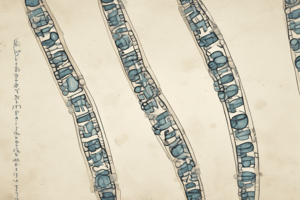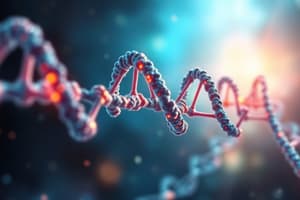Podcast
Questions and Answers
What term is used for any environmental agent that significantly increases the rate of mutation?
What term is used for any environmental agent that significantly increases the rate of mutation?
- Adduct
- Mutant
- Carcinogen
- Mutagen (correct)
Which of the following is classified as a base analog that can induce mutations?
Which of the following is classified as a base analog that can induce mutations?
- Nitrous acid
- Ethylmethanesulfonate
- 5-bromouracil (correct)
- Hydroxylamine
What type of chemical mutation agent is Ethylmethanesulfonate (EMS)?
What type of chemical mutation agent is Ethylmethanesulfonate (EMS)?
- Deaminator
- Base analog
- Oxidizer
- Alkylating agent (correct)
Which of the following agents is responsible for deamination of cytosine?
Which of the following agents is responsible for deamination of cytosine?
How do intercalating agents primarily induce mutations?
How do intercalating agents primarily induce mutations?
What type of reaction does hydroxylamine predominantly induce on DNA?
What type of reaction does hydroxylamine predominantly induce on DNA?
Which of the following best describes the action of reactive oxygen species (ROS) in relation to DNA?
Which of the following best describes the action of reactive oxygen species (ROS) in relation to DNA?
Which class of mutagens includes nitrous acid and impacts DNA by removing an amine group from nucleotide bases?
Which class of mutagens includes nitrous acid and impacts DNA by removing an amine group from nucleotide bases?
What is the primary characteristic of spontaneous mutations?
What is the primary characteristic of spontaneous mutations?
What does the Fluctuation Test demonstrate about mutations?
What does the Fluctuation Test demonstrate about mutations?
Who were awarded the Nobel Prize for their work related to the Fluctuation Test?
Who were awarded the Nobel Prize for their work related to the Fluctuation Test?
What was the purpose of the replica plating technique developed by the Lederbergs?
What was the purpose of the replica plating technique developed by the Lederbergs?
In what type of medium was the master plate created during the replica plating technique?
In what type of medium was the master plate created during the replica plating technique?
What is indicated by the observation that resistant cells are selected by an environmental agent in the fluctuation test?
What is indicated by the observation that resistant cells are selected by an environmental agent in the fluctuation test?
What was a significant finding about the nature of mutations indicated by the fluctuation test?
What was a significant finding about the nature of mutations indicated by the fluctuation test?
Which of the following statements is true regarding induced mutations?
Which of the following statements is true regarding induced mutations?
What is the relationship between the energy of radiation and its wavelength?
What is the relationship between the energy of radiation and its wavelength?
Which type of radiation is considered ionizing?
Which type of radiation is considered ionizing?
What are free radicals?
What are free radicals?
Which of the following can result from exposure to ionizing radiation?
Which of the following can result from exposure to ionizing radiation?
What is the primary source of human radiation exposure?
What is the primary source of human radiation exposure?
What happens to stable molecules when exposed to ionizing radiation?
What happens to stable molecules when exposed to ionizing radiation?
Which radiation type is less energetic than X rays?
Which radiation type is less energetic than X rays?
What is a potential consequence of free radicals affecting DNA?
What is a potential consequence of free radicals affecting DNA?
What is the primary effect of UV radiation on DNA?
What is the primary effect of UV radiation on DNA?
What is a result of guanine oxidation by reactive oxygen species (ROS)?
What is a result of guanine oxidation by reactive oxygen species (ROS)?
At which wavelength does maximum mutagenicity occur due to UV radiation?
At which wavelength does maximum mutagenicity occur due to UV radiation?
Which layer of cells in multicellular organisms is primarily affected by UV radiation?
Which layer of cells in multicellular organisms is primarily affected by UV radiation?
What characterizes DNA-adduct forming agents?
What characterizes DNA-adduct forming agents?
What is a significant outcome of thymine dimers on DNA repair processes?
What is a significant outcome of thymine dimers on DNA repair processes?
Which of the following agents is known to form DNA adducts?
Which of the following agents is known to form DNA adducts?
How does UV radiation primarily induce mutations in unicellular organisms?
How does UV radiation primarily induce mutations in unicellular organisms?
What is a consequence of high-temperature cooking of meats regarding heterocyclic amines (HCAs)?
What is a consequence of high-temperature cooking of meats regarding heterocyclic amines (HCAs)?
What type of mutation can radiation induce?
What type of mutation can radiation induce?
Which of the following is NOT a product of UV absorption by pyrimidines?
Which of the following is NOT a product of UV absorption by pyrimidines?
What role do thymine-cytosine adducts play in DNA mutation?
What role do thymine-cytosine adducts play in DNA mutation?
What type of agents interfere with replication and repair of DNA?
What type of agents interfere with replication and repair of DNA?
How does ionizing radiation differ from UV radiation in inducing mutations?
How does ionizing radiation differ from UV radiation in inducing mutations?
Why are heterocyclic amines (HCAs) considered cancer-causing agents?
Why are heterocyclic amines (HCAs) considered cancer-causing agents?
Which statement regarding DNA intercalating agents is true?
Which statement regarding DNA intercalating agents is true?
Flashcards are hidden until you start studying
Study Notes
Mutagens and Mutation
- Mutagen: Any environmental agent that significantly increases the mutation rate.
- Base Analog: A chemical compound that resembles a normal nucleotide base and can be incorporated during DNA replication.
- Ethylmethanesulfonate (EMS): An alkylating agent that adds an ethyl group to DNA bases.
- Deamination of Cytosine: Can be induced by Nitrous acid.
- Intercalating Agents: Molecules that insert themselves between base pairs in DNA, disrupting its structure and causing mutations.
- Hydroxylamine: Induces mutations by reacting with cytosine, converting it to hydroxylaminocytosine, which pairs with adenine instead of guanine.
- Reactive Oxygen Species (ROS): Highly reactive molecules that can damage DNA, leading to mutations.
- Nitrous Acid: A mutagen that removes an amine group from nucleotide bases.
- Spontaneous Mutations: Mutations that occur naturally without any external influence.
- Fluctuation Test: Demonstrates that mutations occur randomly and spontaneously.
- Fluctuation Test Nobel Prize Winners: Salvador Luria and Max Delbrück in 1969
- Replica Plating Technique: Developed by the Lederbergs, this technique allows the study of mutations and their selection for growth without exposure to a specific environmental agent.
- Replica Plating Master Plate: Made on a non-selective medium, containing all cells regardless of their resistant status.
- Fluctuation Test Resistant Cells: Their appearance indicates that mutations had already occurred before exposure to the environmental agent.
- Fluctuation Test Key Finding!: Mutations are not induced by the environment, but rather, are pre-existing.
- Induced Mutations: Mutations caused by environmental agents.
- Radiation Energy and Wavelength: Inversely proportional - higher energy, shorter wavelength.
- Ionizing Radiation: Highly energetic radiation that can ionize atoms and create free radicals.
- Free Radicals: Highly reactive molecules with unpaired electrons that can damage DNA.
- Ionizing Radiation Consequences: Mutations, DNA breaks, cell damage, and cancer.
- Primary Human Radiation Exposure Source: Medical procedures.
- Ionizing Radiation on Stable Molecules: Can cause instability by breaking molecular bonds.
- Radiation Less Energetic than X-rays: UV radiation.
- Free Radicals on DNA: Can cause mutations, damage, and breaks in DNA strands.
- UV Radiation on DNA: Forms thymine dimers, where two adjacent thymines bond together, disrupting normal DNA structure and function.
- Guanine Oxidation by ROS: Can result in 8-oxo-guanine, which pairs with adenine instead of cytosine, leading to mutations.
- Maximum Mutagenicity of UV Radiation: Occurs at 260 nm wavelength.
- Cells Affected by UV Radiation: Primarily affects the outer layers of cells, such as skin cells.
- DNA-Adduct Forming Agents: Chemicals that bind to DNA and alter its structure, leading to mutations.
- Thymine Dimers on DNA Repair: Present significant challenges for DNA repair mechanisms.
- DNA Adduct Forming Agents: Examples include benzo[a]pyrene, aflatoxin B1, and heterocyclic amines (HCAs).
- UV Radiation on Unicellular Organisms: Triggers mutations by forming thymine dimers.
- High-Temperature Cooking of Meats and HCAs: Can produce HCAs, which are carcinogenic.
- Radiation-Induced Mutations: Can result in point mutations, deletions, insertions, and chromosomal abnormalities.
- UV Absorption by Pyrimidines: Does not produce cytosine dimers.
- Thymine-Cytosine Adducts: Can lead to mutations, particularly transversions (substitution of a purine for a pyrimidine or vice versa).
- DNA Replication and Repair Interfering Agents: Agents that hinder DNA replication and repair processes, like intercalating agents, alkylating agents, and some DNA adduct-forming agents.
- Ionizing vs. UV Radiation: Ionizing radiation can cause more complex damage and breakages compared to UV radiation.
- Heterocyclic Amines (HCAs) as Cancer-Causing Agents: HCAs are potent mutagens, and their prolonged exposure is associated with increased cancer risk.
- DNA Intercalating Agents: Can lead to insertions and deletions in DNA sequences, impacting gene expression and causing mutations.
Studying That Suits You
Use AI to generate personalized quizzes and flashcards to suit your learning preferences.




